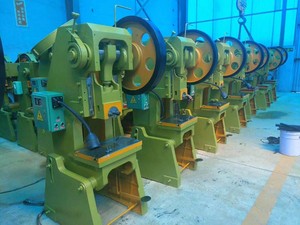(954 products available)




























































































































































































































The J21 punch press machine is popular for providing consistent and reliable performance in industries. Here are the various types based on their working capacity, control system, and power source.
Machine size:
Classification of the press machine size is according to the capacity and tabletop dimensions. Press machine J21's sizes is from small (J21/6) to large (J21/31).
Motor power:
The motor power of the J21 press machine ranges from around 4kW to 30kW, depending on machine size and capacity. Bigger size and higher capacity J21 machines have higher motor power.
Strokelength:
The J21 press machines have different stroke lengths available, typically 20mm to 80mm. Longer stroke lengths allow forming larger parts.
Die mounting:
J21 press machines can mount upper and lower dies. The die mounting methods are according to the press machine models and may vary
Operation methods:
The J21 press machines can be operated manually, semi-automatically, or fully automatically.
Coolant system:
J21 press machines may be equipped with a central or single-machine coolant system for lubricating and cooling dies and parts.
Safety features:
Safety is very important when operating and using the J21 press machines. The machines have various safety features, such as a keyless electromagnetic emergency stop, safety guards, overload protection, etc.
Lubrication :
Lubricate critical components regularly, such as bearings, gears, and guide rails, using the suggested lubricant. Ensure accurate lubrication, and avoid oil leakages and over-supply.
Die cleaning:
Clean the molds used in the press machine frequently, and remove debris, dust, and other contaminants. Use die cleaning fluid for cleaning, and ensure that the die is dried and coated with anti-rust oil before reloading it on the press machine.
Cooling system inspection:
Check the cooling system of the machine, and ensure that the coolant is in the right amount and in good condition. Monitor the machine's operating temperature, and avoid it overheating.
Electrical system maintenance:
Maintain the electrical system of the press machine, and ensure that the circuit is clean and free from loose connections. Periodically, inspect controllers, sensors, and other components to ensure they are working normally.
Safety device check:
Regularly check the safety devices of the press machine, such as emergency stop buttons, safety shields, etc., and ensure they are in good working order and properly operated.
Production capacity:
The parameters of the J21 press machine, such as the nominal pressure, working table size, and press depth, should match the specifications and size of the parts that production demand. Ensure that the machine can handle the required production volume.
Material versatility:
Evaluate the range of materials and thicknesses the J21 press machine can handle. Different gauge steels, such as mild steel, stainless, and carbon steel, require varying machine specifications. Assess whether the machine's adaptability will meet the demands of diverse materials.
Precision and accuracy:
Consider the importance of precision and accuracy in the production process. Select a J21 press machine with features such as digital readouts, CNC control, or closed-loop servo drives to ensure precise depth control and consistency.
Ease of operation:
Evaluate the user-friendliness of the press machine. Look for features that enhance operational convenience, such as quick tool changes, adjustable guides, and digitized controls. These elements contribute to efficient production and minimize downtime.
Safety features:
Inspect and prioritize safety features when selecting a J21 press machine. Verify that it has a two-hand operation, emergency stop button, light curtains, and other necessary safety devices. These components help protect operators and minimize the risk of accidents.
Integration capabilities:
Consider the machine's potential for integration with other systems and automation. Think about future production needs and whether the press machine can connect with feeders, conveyors, or robotics for enhanced efficiency.
Q: What are the differences between J21 and other types of presses (like J30, J23, etc.)?
A: The J21 is distinguished from other types of presses by its working principle, structure, energy source, and applicable scope. The J21 is a frame-style press machine. The J30 is an inverted U-frame-style press machine. The U-frame design offers more uniform pressure and is suitable for larger workpieces. It is common in welding, forging, and machining applications. The J23 press machine is a crank shearing press machine. Its mechanism involves a crank and slider arrangement, which simplifies the machine's construction. The J23 may have less speed than others, but it offers greater precision. The J24 hydraulic press machine is a wide frame machine. It uses the hydraulic system to apply press force. This allows greater control over the force and more consistency in results.
Q: What materials can be used with the J21?
A: The J21 machine is commonly used on aluminum alloy plates, iron sheets, stainless steel plates, and other materials.
Q: How to maintain the J21 press machine?
A: Regular maintenance helps ensure durability and consistent performance. Here are some tips for keeping the press machine intact. Regularly Lubricate the moving parts to reduce the abrasion of parts and ensure smooth operations. Clean the machines regularly. Get rid of dirt, dust, or debris using a dry cloth. This prevents the buildup of contamination that could compromise function. Regularly inspect the machine parts, including vulnerability areas, lubricated parts, and electrical components. Identify any signs of wear or damage, then schedule timely repairs. Ensure the machine operates within the recommended ratings and limits for press power and voltage. This minimizes the risk of stress or overloading.